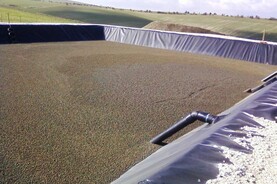This week, I feature two items of safety equipment installed in the slatted tanks of the new suckler shed at Teagasc Grange.One is a permanent suction point, which allows a tank to be emptied without opening an agitation point. The other is a circulation pipe, which allows agitation be carried out on a long tank without using an internal agitation point.
This week, I feature two items of safety equipment installed in the slatted tanks of the new suckler shed at Teagasc Grange.
One is a permanent suction point, which allows a tank to be emptied without opening an agitation point. The other is a circulation pipe, which allows agitation be carried out on a long tank without using an internal agitation point.
Both items are relatively low cost, particularly when installed during a new build. They could also be retrofitted to an existing tank and the circulation pipe is eligible for grant aid under the new Targeted Agricultural Modernisation Scheme (TAMS). They were designed by buildings specialist JJ Lenehan and supplied and fitted by PJ Dore & Co of Co Limerick.
Picture one
These are the agitation points fitted on the new tanks at Grange. They are a modern design, give a good degree of safety during agitation and – with a bolt or lock – can be made childproof.
Picture two
However, at emptying time, lids and safety grid are often left open while the tanker is gone to the field with the suction pipe in place. This presents a safety risk.
Picture three
This is a safer alternative – a connection point for the tanker’s filling pipe, fixed permanently in place. A vacuum tanker can be hooked up to this connection point using a short length of hose. The end fitting is a standard snap-on coupler.
Picture four
Here is one of the permanent emptying pipes fixed in place down in the tank. It is a 150mm (6in) high-density polyethylene pipe. JJ Lenehan said that a 150mm pipe is required to give a fast filling rate for the tanker. We can see that the pipe runs down to floor level and will allow the tank to be fully emptied.
The manhole/agitation point can be left closed while the tank is emptied through this suction pipe. There are obvious safety benefits.
Picture five
The second safety item is a circulation pipe running the length of the tank. Again, a connection is placed in the slab outside the shed where the outlet pipe of an agitator pump can be connected.
Slurry is pumped through the pipe, emerging at the far end and boosting circulation. This circulation pipe has a role where it is not possible to install an external agitation point at both ends of the tank. Having this pipe removes any need to install an internal agitation point.
Why is circulating slurry via this pipe safer than using an internal agitation point? JJ Lenehan told me that when slurry is agitated, hazardous gases emerge from under the slats. If the agitation is carried out inside the shed, there is a temptation for the driver to remain near the tractor and agitator to keep an eye on things. He or she is then at risk of breathing in slurry gases.
The driver has to come into the shed to stop the equipment and can again be at risk of breathing in slurry gases.
Contrast this with what happens when the agitator/pump doing the circulation is located outside the shed, at an external agitation point. The gases continue to emerge under the slats, inside the shed. Now, however, a driver approaching the equipment is at a lower risk of being exposed to the gases.
The tanks in the Grange shed have agitation points at one end only. There are calving pens at the other end. The tanks are four 4.8m bays long with an additional 1.2m outside at one end – approximately 20m (65ft) long in all. Internal agitation points have not been fitted. “If we had external agitation points at both ends of the tanks, we would not have fitted the circulation pipe,” JJ said.
Picture six
The pipe is held in place with stainless steel brackets, bolted into the tank concrete. Without brackets, the force of the pump would have the pipe bouncing around. Here, we see where the pipe comes down from the connection point to meet the tank floor.
The pipe is 125mm (5in) high-density polyethylene, as used in water mains, JJ said. Using a larger pipe would facilitate increased flow rate from the pump but exit velocity of the slurry from the end of the pipe would be lower.
Picture seven
The Grange tank has a spine wall. The pipe end points the slurry around the end of the spine wall.
In the Grange tank, the pipe runs along the floor of the tank. But a pipe can also run along at the top of the tank wall just under the slats. Where a pipe is being retrofitted into an existing tank, running it along the top of the tank wall could be the easier option. In addition, the jet of slurry would help to break up any crust lying on the top surface of the slurry tank.
PJ Dore & Co are based in Co Limerick. PJ told me that the equipment shown here costs €3,500 installed. That includes a circulating pipe and an emptying pipe in each tank, all with permanent connection points in the concrete slab outside the shed. The connection points are fitted with Bauer couplers, allowing easy connection
to a slurry tanker or agitator pump, as required.





SHARING OPTIONS: